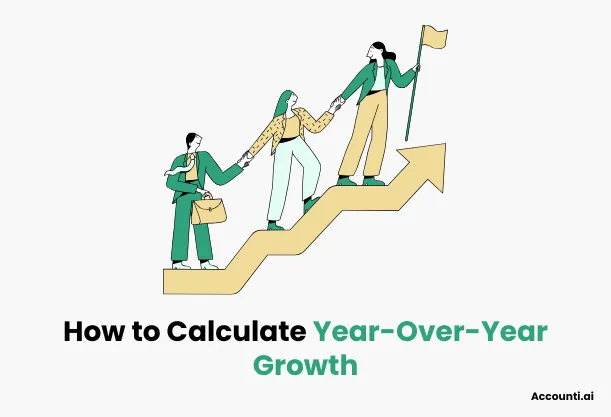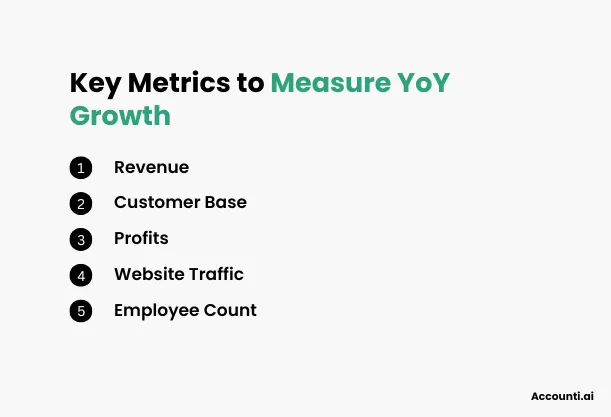
How to Calculate Year-Over-Year Growth: Simple Guide with Examples, Formula
Understanding Year-over-Year (YoY) growth is crucial for anyone looking to track progress, whether in business, finance, or personal milestones. YoY growth is a great metric because it offers a direct comparison of performance, eliminating seasonal effects or short-term fluctuations.
In this guide, we’ll explore what YoY growth is, why it matters, how to calculate it step-by-step, and the common mistakes to avoid. By the end, you’ll have a clear picture of YoY growth and how it can help measure success over time.
What is Year-Over-Year (YoY) Growth?
Year-over-Year growth is a comparison of a metric’s performance over the same period from the previous year. This metric is used widely in business and finance to measure changes in metrics like revenue, sales, profits, or user base over a year.
In simpler terms, if you’re comparing performance between March 2024 and March 2025, you’re looking at YoY growth. It helps gauge long-term trends by looking at whether the performance has improved or declined over a full year.
Why YoY Growth Matters
1. Tracks Long-Term Trends
Unlike month-over-month comparisons, which can be affected by short-term fluctuations or seasonal trends, YoY growth offers a long-term perspective. For example, if your sales consistently increase year-over-year, it’s a sign of sustained growth.
2. Eliminates Seasonal Effects
Seasonal businesses, like retail, may see huge spikes in certain months (think holiday season). YoY growth factors out these effects by comparing the same time each year.
3. Provides an Easy Benchmark
YoY growth offers a clear, comparable metric that’s easy to understand. You can quickly see if you’re doing better, worse, or about the same as last year.
How to Calculate YoY Growth
Calculating Year-over-Year growth involves a straightforward formula. Here’s the basic formula:
YoY Growth=Previous Year Value(Current Year Value−Previous Year Value)×100
This formula gives you the growth rate as a percentage. Let’s break it down:
Step-by-Step Calculation of YoY Growth
- Identify Your Current Year Value: This is the metric for the period you want to measure. For example, if you’re looking at revenue, take the revenue for the current period, such as Q1 2025.
- Identify Your Previous Year Value: Find the same metric from the previous year, such as Q1 2024 revenue.
- Apply the Formula: Subtract the Previous Year Value from the Current Year Value, divide by the Previous Year Value, and then multiply by 100 to get a percentage.
Example Calculation
Let’s say your company made $120,000 in Q1 2025, compared to $100,000 in Q1 2024. Here’s how you calculate YoY growth:
YoY Growth = 100,000 (120,000 − 100,000) × 100 = 20%
This 20% YoY growth means that revenue increased by 20% compared to the same period last year.
Key Metrics to Measure YoY Growth
When it comes to business, YoY growth can be applied to a wide range of metrics. Here are some common ones:

1. Revenue
Revenue is one of the most critical metrics for YoY growth. Businesses often track revenue YoY to see if sales and income are growing over time.
2. Customer Base
Tracking the growth in the number of customers year-over-year helps gauge the popularity of products or services.
3. Profits
Measuring YoY profit growth is valuable to see if a company’s bottom line is growing alongside its revenue.
4. Website Traffic
For online businesses, YoY growth in website traffic is a great way to track digital presence and engagement.
5. Employee Count
If a company is growing, employee count might be tracked YoY to assess workforce expansion.
Factors That Can Affect YoY Growth
YoY growth can be influenced by a variety of factors, both internal and external. Understanding these factors is key to interpreting your YoY growth accurately.
1. Market Conditions
Changes in the market can impact YoY growth. Economic downturns, shifts in customer demand, or new competitors entering the market can all affect performance.
2. Seasonality
Seasonal businesses experience natural fluctuations in certain periods. For example, retail companies often see a spike in Q4 due to holiday shopping.
3. New Product Launches
Launching a new product can create a surge in YoY growth, making it essential to factor in these events when analyzing the numbers.
4. Economic Changes
Interest rates, inflation, and other economic variables can impact consumer behavior and affect business performance YoY.
YoY Growth Calculation Examples
Example 1: Simple YoY Growth Calculation
Imagine you own a bakery, and your revenue was $50,000 in 2024 and increased to $65,000 in 2025. To calculate the YoY growth:
YoY Growth = 50,000 (65,000 − 50,000) × 100 = 30%
This 30% growth indicates a positive upward trend in your bakery’s revenue.
Example 2: Complex Calculation with Multiple Metrics
If you want to track revenue and customer growth simultaneously, you might see something like this:
- Revenue 2024: $200,000
- Revenue 2025: $260,000
- Customers 2024: 500
- Customers 2025: 750
YoY Growth for Revenue:
YoY Growth = 200,000 (260,000 − 200,000) × 100 = 30%
YoY Growth for Customers:
YoY Growth = 500(750−500) × 100 = 50%
With 30% revenue growth and 50% customer growth, you’re expanding your customer base rapidly, which is a good sign.
Tools for Tracking YoY Growth
1. Spreadsheets (Excel or Google Sheets)
Most people start with Excel or Google Sheets for YoY calculations. They’re easy to use and perfect for simple formulas.
2. Business Intelligence Software
Tools like Tableau, Power BI, and Google Data Studio can automate YoY tracking and visualize trends over time.
3. Accounting Software
Software like QuickBooks or Xero often includes YoY reports, making it easy for business owners to view growth trends.
4. Financial Service Providers
For businesses looking to manage their Year-over-Year growth tracking without dedicating internal resources, financial service providers like Accounti offer a great solution. Accounti specializes in bookkeeping, financial reporting, and operational support, making it easier to keep accurate records and access critical insights for analyzing growth trends. Their services streamline financial management, allowing business owners to focus more on strategy and growth.
Common Mistakes to Avoid in YoY Growth Calculation
1. Ignoring Seasonality
Don’t compare seasonal periods without accounting for them. A summer spike might look like growth if compared with winter numbers but isn’t truly reflective of annual growth.
2. Using Incorrect Timeframes
Ensure you’re comparing the same periods; otherwise, the growth won’t be accurate.
3. Overlooking External Factors
Economic conditions, market changes, and other factors can influence YoY growth. Always keep external factors in mind when analyzing the data.
4. Not Accounting for New Products or Services
If you launched a major product or service, it could cause a surge in growth. When interpreting YoY growth, consider these events.
Conclusion
Year-over-Year (YoY) growth is an invaluable metric for tracking long-term success. By understanding YoY growth, you can see how your business is evolving, separate real growth from seasonal changes, and make data-driven decisions. Whether you’re a small business owner tracking revenue or a manager looking at customer growth, YoY growth helps you see the bigger picture.
FAQs
What is the formula for year-to-year growth?
The formula for calculating year-over-year (YoY) growth is:
YoY Growth (%)=(Previous Period ValueCurrent Period Value−Previous Period Value)×100
This formula measures the percentage change between two comparable periods, typically the same period in consecutive years.
How do you calculate percentage growth year-over-year?
To calculate the percentage growth year-over-year:
- Subtract the previous year's value from the current year's value.
- Divide the result by the previous year's value.
- Multiply by 100 to convert to a percentage.
For example, if your revenue was $100,000 last year and $120,000 this year:
YoY Growth (%) = (100,000120,000 − 100,000) × 100 = 20%
How do I calculate year-over-year growth in Excel?
To calculate YoY growth in Excel:
- Organize your data with the previous year's value in cell A1 and the current year's value in cell A2.
- In cell A3, enter the formula:
=(A1A2−A1)×100 - Press Enter to get the YoY growth percentage.
This formula subtracts the previous year's value from the current year's, divides by the previous year's value, and multiplies by 100 to express the growth rate as a percentage.
How to calculate average year-on-year growth?
To calculate the average year-on-year growth over multiple periods:
- Calculate the growth rate for each year using the YoY formula.
- Sum all the individual growth rates.
- Divide by the number of periods to find the average growth rate.
Alternatively, for a more precise measure over multiple periods, you can use the Compound Annual Growth Rate (CAGR) formula:
CAGR (%)=(Beginning ValueEnding Value)n1−1
Where nnn is the number of years. Multiply the result by 100 to express it as a percentage.
How do you calculate year over year GDP growth?
To calculate the year-over-year GDP growth rate:
- Obtain the GDP values for the current year and the previous year.
- Subtract the previous year's GDP from the current year's GDP.
- Divide the result by the previous year's GDP.
- Multiply by 100 to express the growth rate as a percentage.
For example, if the GDP was $5 trillion last year and $5.2 trillion this year:
GDP Growth Rate (%)=(5trillion5.2trillion−5trillion)×100=4%
This indicates a 4% growth in GDP compared to the previous year.

 Rohit Kapoor
Rohit Kapoor

